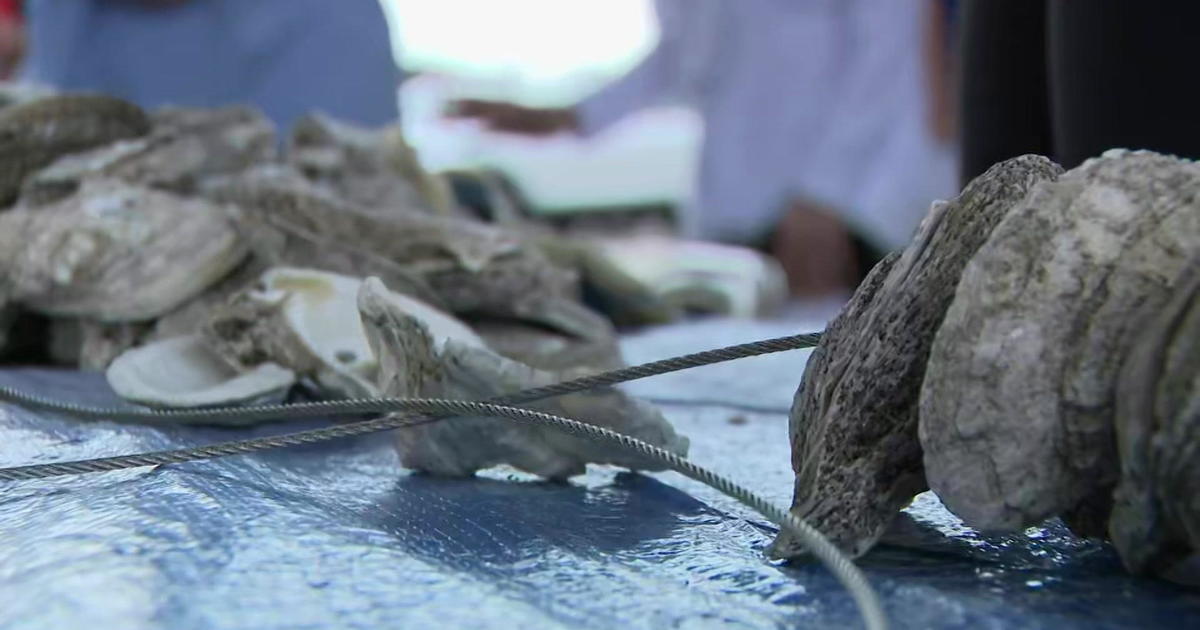Miami's Past To Make Way For New Entertainment Complex
MIAMI (CBSMiami/AP) – Miami's past uncovered near the river in the downtown area will soon be covered over, after some of the artifacts are removed, to make way for an entertainment complex known as Met Square.
At the site are three smooth concrete steps leading down to a tiled floor, a remnant of industrialist Henry Flagler's grand Royal Palm Hotel, which gave birth to modern Miami and its tourism industry. There are the brick bases of the columns that once held up the hotel's famed veranda.
A few more steps down bring you to a pattern of ancient postholes bored in the bedrock, likely for Tequesta Indian village structures and likely well more than 1,000 years old.
And then perhaps the most remarkable find: the worn limestone of the original shoreline at the confluence of the Miami River and Biscayne Bay, long ago covered with fill as Flagler and his successors extended the downtown land mass for development.
When archeologist Bob Carr and his crew took away the dirt at that spot, they discovered, much to their surprise, a natural freshwater spring, still bubbling up from the acquifer after all these years.
"That this has always been a prime location is evident from the thousands of objects we have found from the people who lived here," said Carr, whose nonprofit Archaeological and Historical Conservancy has been digging in phases on the Met Miami properties since 2005. "What's exciting about this project is you get to slice through time, from ancient times right through modern times."
What Carr's work has shown is that, while Miami may not be Rome, it has a longer and more layered history than many of the tens of thousands of downtown office workers who daily throng the area can imagine. Carr, who discovered the Miami Circle on the south bank of the river's mouth in 1998, says he now believes the Tequesta settlement extended to both sides of the river, and may have reached as far west as Miami Avenue and as far north as present Flagler Street.
It was long known that the Tequestas, a tribe of hunters and fishermen, thrived on the north bank of the river for some 2,500 years before European disease wiped them out in the 1700s. To build his hotel, Flagler's engineers flattened and removed a Tequesta burial mound; those remains are probably buried under a nearby office building, Carr believes. An Indian midden, or refuse mound, is preserved beneath the pool deck of the Hyatt hotel nearby.
But that so much remains to be found is thanks largely to the fact that nothing but a series of parking lots was built on the site after the Royal Palm, erected in 1897, was damaged by the 1926 hurricane and subsequently demolished. And though the hotel was taken down in sections, pieces sold off, and the rest burned, its foundations, underflooring and other structural elements were left in place.
A city law requires archaeological assessment in certain zones before construction can proceed.
Since Carr began exploring the former Royal Palm site, he and his assistants have uncovered surprisingly extensive remnants of the hotel, which boasted the first sewer and fire-suppression systems, electric lights, elevators and swimming pool in Miami. Those finds include foundations, pipes, pieces of wooden walls still coated in Flagler's signature yellow paint, bricks still legibly stamped "AUGUSTA," presumably for their origins in Georgia, and thousands of small artifacts such as hotel keys.
In the layer below, the archaeologists found extensive evidence of a Tequesta settlement, including rudimentary tools, fragments of bones and shells from the fish and animals that fed the Native Americans. And on the lot where a Whole Foods market is now under construction, they discovered an Indian cemetery with the fragmentary remains of an estimated 500 people. Those remains have been reburied in an undisclosed location under the guidance of the Seminole Tribe.
Artifacts, meanwhile, have been analyzed, logged and sent to the HistoryMiami museum, where significant pieces have been used in exhibits, including a large turtle shell from the Miami Circle.
Also reburied on site was the second circular pattern of postholes discovered by Carr and dubbed the Royal Palm Circle. Probably the foundation of a house or houses, this was a double ring, and not as elaborate or substantial as the Miami Circle, which was preserved after an international outcry.
The Miami Circle, which carbon dating put at 1,700 to 2,000 years of age, consists of 24 holes cut into the limestone in a perfect circle, probably the foundation for a structure that some historians believe had a ceremonial use. The Miami Circle is now a state archaeological park.
Carr began digging on the present site, the last undeveloped piece of the Met properties, in November. (Other phases of the project include the Met One residential tower, the Wells Fargo Center office tower and the adjacent Marriott Marquis hotel, 255 Biscayne Blvd. Way.)
The latest dig also uncovered a third, roughly circular, pattern of postholes, like the Miami Circle about 38 feet in diameter, probably the foundation for a house sited on the river bank near the freshwater spring. Because carbon dating has yet to be performed, Carr doesn't know how old the house is, but he said it likely dates back at least 1,000 years.
"All of these things have a story to tell about the prehistoric people of downtown Miami and about the ancient environment, and how much it has changed and degraded because of urbanization," he said. "It was an interesting to see fresh water coming out in downtown Miami. At one time these springs were all along the shoreline of Biscayne Bay. They're still there, but they're under all these buildings and fill."
Calling Carr's latest findings "really fascinating," Miami historian Paul George said it's too bad they can't feasibly be preserved on site. But he also finds a bright lining in the site's redevelopment with residential buildings and an entertainment center that will include movie theaters, harking back to the heyday of downtown Miami in the 1950s.
The new buildings will conceal Miami's physical history, but bring new life to a site that's been dormant for too long, he said.
"We're not going to be around to see these things again," George said. "Judging from the size of these buildings, they will be around for generations. What can you do?
"But this is the birthplace of this whole area, and now we're coming back to it."
(TM and © Copyright 2013 CBS Radio Inc. and its relevant subsidiaries. CBS RADIO and EYE Logo TM and Copyright 2013 CBS Broadcasting Inc. Used under license. All Rights Reserved. This material may not be published, broadcast, rewritten, or redistributed. The Associated Press contributed to this report.)



